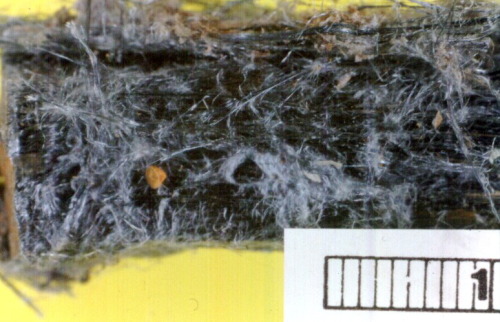What is Asbestos?If you’re like many of the students I’ve had in class, you’ve heard of asbestos tha
What is Asbestos?If you’re like many of the students I’ve had in class, you’ve heard of asbestos thanks to either ads on television for law offices who process asbestos-related claims or through warning labels on big plastic sheets that appear in the hallways whenever work is being done in an old university building. For many people, asbestos is simply “bad”; something to be avoided at all costs. This series of posts will describe asbestos, what it was use used for and why, and what it does to people. For anyone who reads these who was actually harmed by asbestos…please bear with me, I promise this series will cover your issues fairly.From a geologists perspective, asbestos isn’t even a single mineral, it’s a mineral “habit”, a shape taken by a class of minerals. This mineral habit is defined by fibers like those seen in this electron microscope image; tiny mineral fragments that are long in one direction, but are usually so tiny that the human eye has a tough time seeing them.Asbestos minerals are silicates, the most common mineral class on earth, built around the backbone of the silicon-oxygen bond, but with 2 possible different arrangements, each from a different mineral group.The first of these minerals, amphiboles, are double-chain silicates, and their molecular structure is outlined in the second image. Amphiboles are built by a series of 4 silica tetrahedra (with the silicon atom at the center surrounded by 4 oxygen atoms) that share oxygen atoms at their corners and extend in one direction. To balance the charges, these silicate backbones hold metal ions such as calcium, iron, and magnesium, at various points in their structure.The bonds between silicon atoms are extremely strong and hard to break, while the bonds between silica and metal are weaker. Amphiboles often break into elongate needles, with their shape controlled by the patterns between those strong and weak bonds. Not every amphibole mineral forms fibers– many form larger crystals, but there are 5 different minerals which do: amosite, crocidolite, anthophyllite, tremolite, and actinolite. Each of those minerals has the same basic structure but different ions in it, causing different colors, slightly different fiber shapes, and even different levels of harm to humans.The other type of asbestos, chrysotile, is a totally different type of mineral known as a serpentine. Serpentine minerals are silicates that form when mafic rocks like those from Earth’s mantle are exposed to water and chemically weathered. The atomic structures reorganize from the initial mineral form and begin including water molecules, creating alternating sheets of silicon atoms, oxygen atoms, and water-rich layers.Chrysotile asbestos does something really weird. See the flat sheet illustrated in the diagram? Imagine bending that sheet around itself into a tube, like a piece of paper. That’s exactly how chrysotile asbestos forms fibers; the sheets bend around and bond into a single tube, creating a structure strong in one direction and completely isolated in the others. These two types of minerals often form in similar environments – through the interaction of rocks and water, so it isn’t uncommon to find them together. They form large deposits, able to be mined in huge quantities. They even outcrop at the Earth’s surface and can be walked on or collected as samples. The key feature of asbestiform minerals is that their molecular structure shapes them into fibers, long in one direction and short in the other 2.-JBBImage credits: http://en.wikipedia.org/wiki/Asbestos#mediaviewer/File:Anthophyllite_asbestos_SEM.jpghttp://chempaths.chemeddl.org/services/chempaths/?q=book%2FGeneral+Chemistry+Textbook%2F1174%2Fintroduction-ambit-chemistry&title=Using_Crystallography_to_Test_Materials_for_Asbestoshttp://upload.wikimedia.org/wikipedia/commons/1/16/Blue_asbestos_(teased).jpg -- source link
Tumblr Blog : the-earth-story.com
#asbestos#science#geology#chemistry#mineral#minerals#silica#amphibole#chrysotile#amosite#crocidolite#anthophyllite#tremolite#actinolite#riebeckite#needle#fiber


